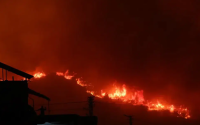29 December 2004Christian Christensen
As the number of casualties following the tsunamis that struck south-east Asia and parts of east Africa reaches the 60,000 mark, I find myself falling prey to one of the most unpleasant side-effects of 24-hour television and web news coverage: an addiction to death-toll pornography. Like a junkie who finds himself locked inside of a drug store, with uninterrupted access to CNN, the BBC and the web I have an inexhaustible supply of material to feed my self-destructive habit.
When the news of the catastrophe broke on Sunday, early estimates put the number of dead at around 5,000. By the end of Tuesday, that number had jumped to over 50,000. News anchors and reporters regularly updated the audience on the "latest" figures, and "news tickers" at the bottom of the screen flashed casualty numbers like so much stock market information or so many football scores.
As the numbers continue to grow, however, my humanity and compassion seem to diminish. Initial horror upon hearing the news has morphed into an urge to hear more updates and to see more video footage of massive waves washing away cars, hotels, boats, and, in case we forget, people. As the numbers rocket upward, I play a macabre guessing game. How high will the death count go? 100,000? 200,000? Could it be a quarter of a million? The numbers are so huge, and my experience with death on this scale (or any scale, for that matter) so minuscule, that I simply cannot comprehend what is going on, Statistics are the only thing I can lean on.
I can only speak for myself, of course, but my guess is that I am not alone in my occasional addiction to death-toll pornography. I consider myself to be a relatively critical person when it comes to the media, and yet, for some reason, I continue to kid myself that by watching hour after hour of news coverage from India, Thailand and Sri Lanka I am a "well-informed" person. In all honesty, I crossed that "well-informed" line a long time ago, and so I have come to the conclusion that I am watching the aftermath of this natural disaster for reasons other than pure information. It isn't entertainment, but it is a form of fascination that taps into a primal fear of death.
What jolted me out of my self-deception - and brought me to write this article -was something that I saw this morning on the BBC news. In the middle of some stock crisis footage from Thailand, there was a brief shot of the naked corpse of a young man hanging from the branch of a tree. The fact that I was sitting in my comfortable living room, drinking coffee, looking at a naked corpse in a tree convinced me that what I was watching was not news, but a perverted form of reality television. I wondered how I would feel if that naked boy had been a member of my family: his undignified death a passing spectacle for all the world to see over their mugs of morning coffee.
The bigger the number of victims, and the further away they live from us, of course, the easier it becomes to distance ourselves from what we are watching. We can accept video of hundreds of anonymous bodies washing up onto the shores of southern India, but would we accept video of the corpse of a young girl floating in a neighborhood swimming pool being shown on our local news? Through the news, we have become accustomed to seeing people in the developing world as victims: victims of war, victims of famine, victims of disease, and victims of natural disasters. In their eternal state of victim-hood, these people have had their right to individuality and dignity stripped, and thus their corpses are fair game for the evening news.
None of this is to say that this is not a story worthy of round-the-clock coverage, because it is. What I am suggesting, however, is that we should be thinking about the mode of the coverage: the obsession with death tolls (most of which are inaccurate anyway), the repetition of horrific footage, and close-up pictures of obviously grieving family members.
Coverage of the crisis is needed to alert the world to what is a massive humanitarian disaster, and showing death is a part of that. What is not needed, however, is coverage that panders to the dark, voyeuristic sides of our psyches.
Christian Christensen is an Assistant Professor in the Faculty of Communication at Bahcesehir University in Istanbul, Turkey. He can be reached at [email protected].
http://www.commondreams.org/cgi-bin/print.cgi?file=/views04/1229-10.htm






